LAB REPORT
Science and Technology Making Headlines
Sept. 24, 2021

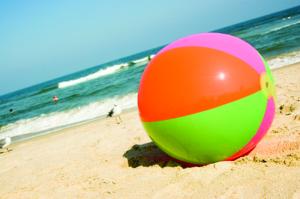
LLNL scientists have calculated moment tensors, often represented graphically as "beach balls” for underground nuclear and chemical test explosions.
‘Beach balls’ can aid in monitoring nuclear tests
LLNL researchers have calculated moment tensors for 130 underground nuclear and 10 chemical test explosions that took place at the Nevada National Security test site.
Often represented graphically to resemble a striped "beach ball," moment tensors “are essentially a mathematical concept that's used to describe forces that drive earthquakes,” said LLNL scientist Andrea Chiang.
Instead of the forces along an earthquake fault, the moment tensor solutions calculated by Chiang and LLNL’s Michael Pasyanos represent the forces of implosion, explosion and collapse that occurred during the underground tests. These calculations, the researchers show, can be used to distinguish explosions from earthquakes, and estimate yield for the explosions.
Pasyanos and Chiang said compiling an extensive database of moment tensor solutions for this unique set of carefully documented explosions will be useful for researchers tasked with explosion monitoring. Their data set reflects nuclear explosions at the site from 1970 to 1992, and chemical explosions from 1993 to 2019.

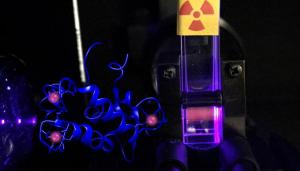
The glowing/pinkish sample to the right is an actual sample containing radioactive curium and the protein lanmodulin, during a fluorescence spectroscopy experiment at LLNL. The protein makes curium glow when exposed to UV light. In the presence of the protein, curium luminescence becomes strong enough to be observed by the naked eye. The schematic represents the structure of the curium-protein complex, with three curium atoms bound per molecule of protein.
Looking to nature for nuclear waste management
Lawrence Livermore scientists and collaborators proposed a new mechanism by which nuclear waste could spread in the environment.
The new findings, that involve researchers at Penn State and Harvard Medical School, have implications for nuclear waste management and environmental chemistry.
“This study relates to the fate of nuclear materials in nature, and we stumbled upon a previously unknown mechanism by which certain radioactive elements could spread in the environment,” said LLNL scientist and lead author Gauthier Deblonde. “We show that there are molecules in nature that were not considered before, notably proteins like ‘lanmodulin'’that could have a strong impact on radioelements that are problematic for nuclear waste management, such as americium, curium, etc.”
Past and present nuclear activities (energy, research, weapon tests) have increased the urgency to understand the behavior of radioactive materials in the environment. Nuclear wastes containing actinides (e.g. plutonium, americium, curium, neptunium...) are particularly problematic as they remain radioactive and toxic for thousands of years.

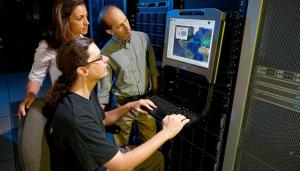
LLNL in partnership with Los Alamos National Laboratory and Sandia National Laboratories, has awarded a subcontract to Dell Technologies for additional supercomputing systems to support the National Nuclear Security Administration’s (NNSA's) nuclear deterrent mission.
Lab unites with Dell
Lawrence Livermore this week announced the awarding of a subcontract to Dell Technologies for additional supercomputing systems to support NNSA’s nuclear deterrent mission in partnership with Los Alamos National Laboratory(LANL) and Sandia National Laboratories (SNL)
The second Commodity Technology Systems contract (CTS-2) is funded by the National Nuclear Security Administration’s Advanced Simulation and Computing (ASC) program. It will provide at least $40 million for more than 40 petaFLOPs of expanded computing capacity delivered to the NNSA Tri-Labs (LLNL, LANL, and SNL). A petaFLOP is one quadrillion floating-point operations per second.
The computing systems built under the CTS-2 contract will be deployed at the Tri-Labs in building blocks called “scalable units” (SUs), with each SU representing approximately 1.5 petaFLOPs of computing power. Initial system deliveries are scheduled to begin in mid-2022 and will continue through 2025. They will replace the current ASC commodity systems which were sourced by the 2015 CTS-1 contract and are now nearing retirement.
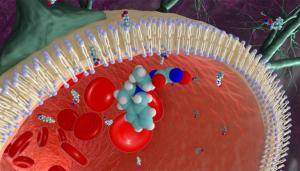
LLNL-02 can pass through the blood-brain barrier (pictured), making it more effective in protecting the central nervous system. Image by Liam Krauss/LLNL.
Crossing the blood-brain-barrier
Scientists at Lawrence Livermore National Laboratory have developed a new, versatile antidote to counteract exposure to nerve agent poisoning.
Chemical weapon nerve agents like Sarin or Novichok typically function by blocking the transmission of messages from the central nervous system (CNS), composed of the brain and the spinal cord, to the peripheral nervous system (PNS), which controls many processes, including respiration. The brain’s natural protection — the blood-brain barrier (BBB) — has long been a major obstacle to the development of effective nerve agent antidotes, which historically only protect against damage to the PNS because they cannot cross the BBB.
After the most promising compounds were identified using a parallel effort involving computational modeling and medicinal chemistry, the best candidates were evaluated in several biochemical assays, resulting in the discovery of LLNL-02. LLNL-02 was found to protect both the CNS and the PNS against the effects of the nerve agent Sarin. LLNL-02 is the first antidote of its kind, as it does cross the BBB to ensure protection to the brain.

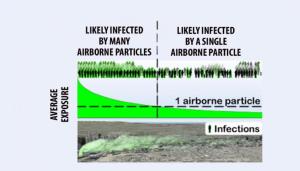
Illustration of where people can be infected by many (left) or a single (right) airborne particle. Single particle infections can occur far downwind.
Going outside? Beware of airborne particles
For some diseases, people exposed to just a single airborne particle containing infectious virus, bacteria or fungi can be infected. When this happens, understanding and predicting airborne disease spread can be a whole lot easier.
That’s the result of a new study by a Lawrence Livermore National Laboratory (LLNL) scientist who developed a new theory of airborne infectious disease spread. This research demonstrated good agreement with data from Q fever, Legionnaire’s disease and Valley fever outbreaks. The authors hope to use it to understand and mitigate COVID-19 spread.
Some diseases spread when you breathe in infectious airborne particles. These airborne diseases are a major world health problem. According to the World Health Organization, lung infections are the fourth leading cause of death worldwide and Tuberculosis is a leading cause of death in lower income countries. As scientific studies have shown, airborne diseases caused by viruses, bacteria, and fungi can spread over distances ranging from a few feet up to hundreds of miles. Individual airborne disease outbreaks have affected thousands of people.





